Liberty Head Half Dollar
1892 to 1915
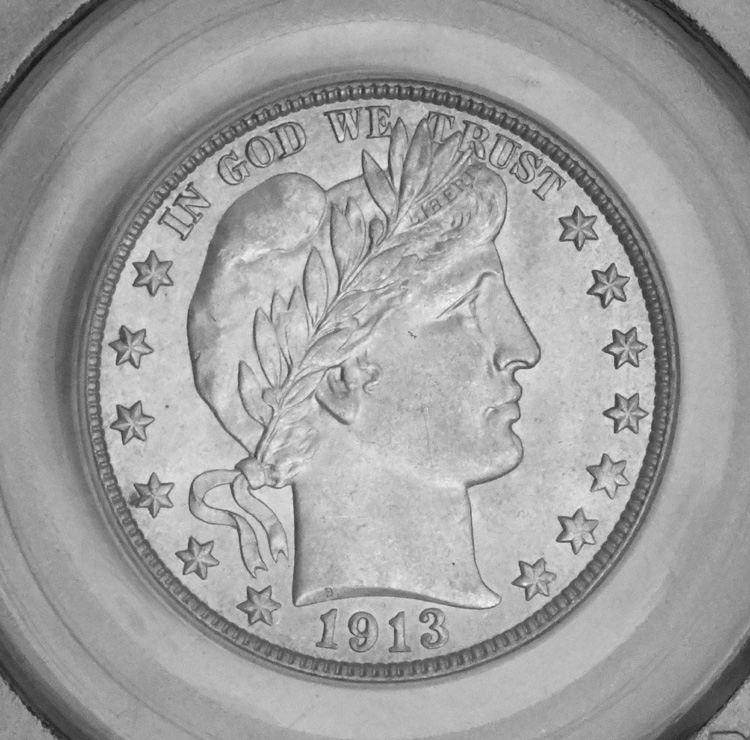 |
The Liberty Head, or Barber, half was designed and appeared in 1892. The reverse of the coin displays a shield eagle with wings spread wide and holding arrows and a branch. This coin was minted in Philadelphia, New Orleans, San Francisco, and in later issues, Denver. Although the weight was slightly greater than its predecessor, the diameter was the same. None of these coins is especially rare but some issues do cost over $100 and those in uncirculated condition are all valued at more than $500. The Barber half is particularly popular among collectors. |
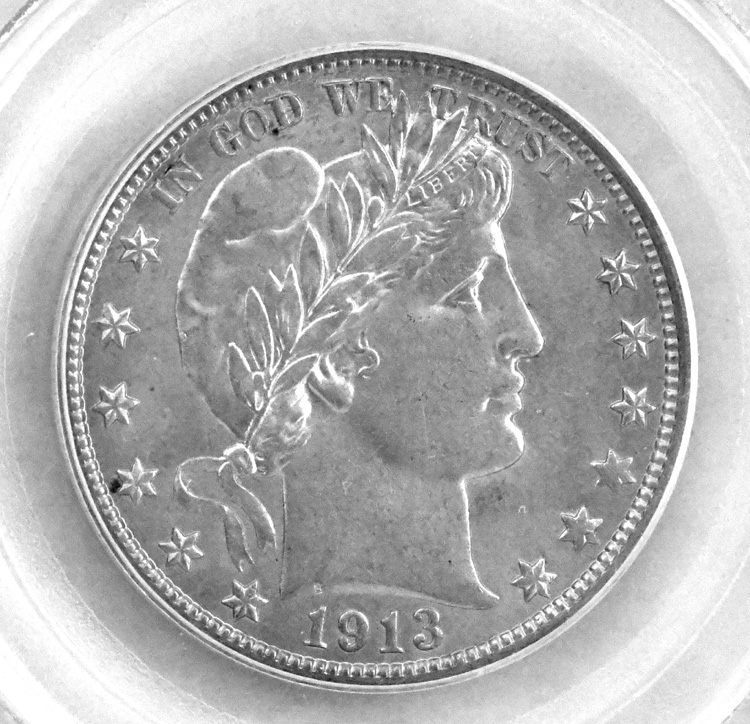 |
| This is the only certified uncirculated Barber half that I own and it cost me a bundle! The coin is certified by PCGS as an MS63 and was minted in Denver. I bought it primarily to increase my collection of uncirculated old coins in numerous styles and to image the coin for this web site. | This is another photo of the same coin at left under different lighting. The coin is stored in the red box in the SDB 508 in the bank. It is worth about $1000. | |
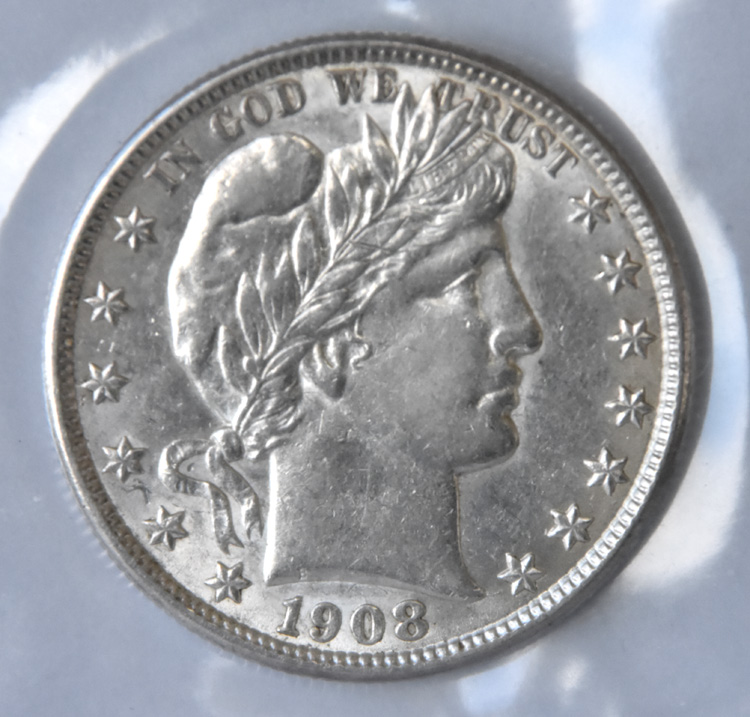 |
|
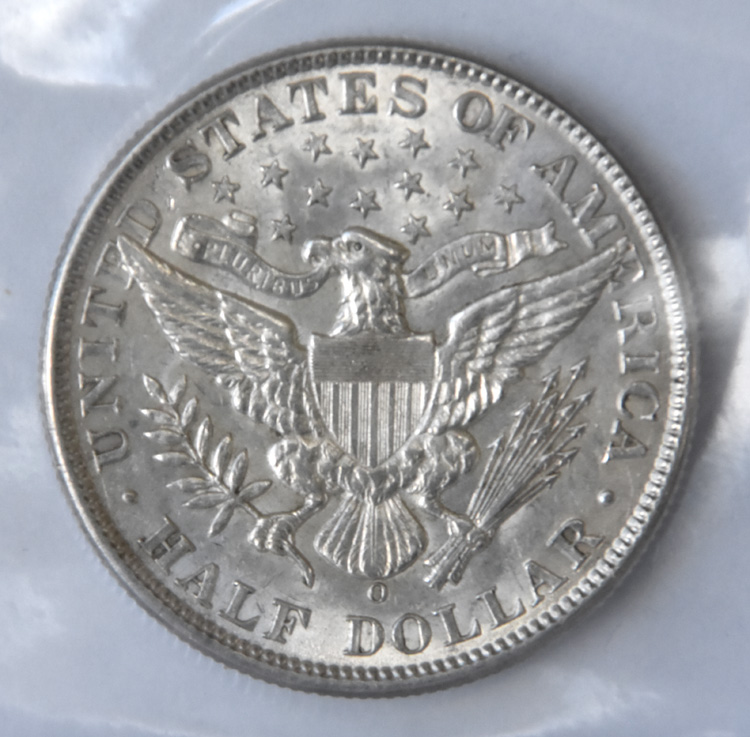 |
| This example above was graded BU by the seller and cost me $290 and is worth about $375 today, if the coin is actually about uncirculated. The coin was graded BU by the seller but I have since learned that they are very dishonest and thus, I am quite sure that the coin is AU at best. The only way to pin down the correct grade is to send it to ANACS, something I am not ready to do as of this date - 2017. I have a complete set of these coins in an album. | This is the reverse of the coin at left. | |
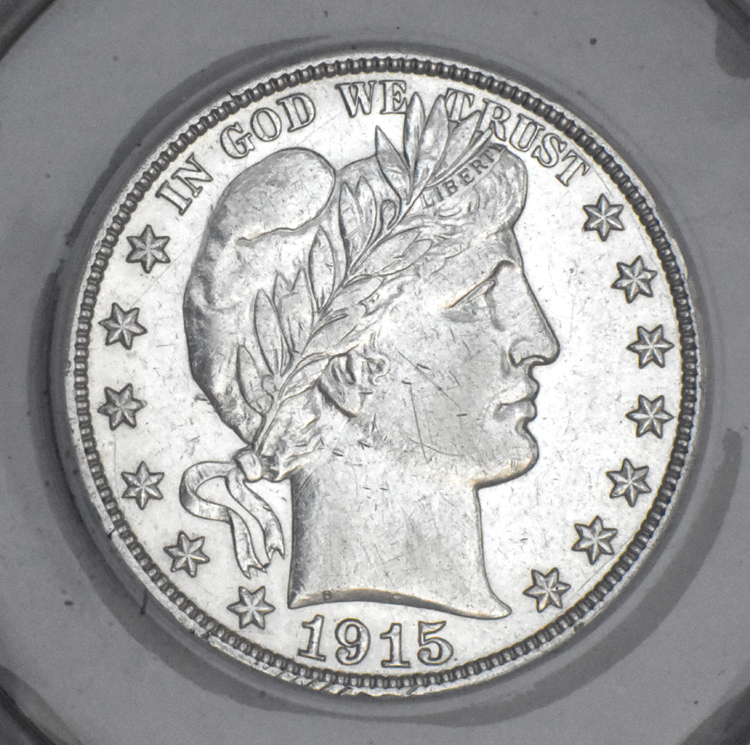 |
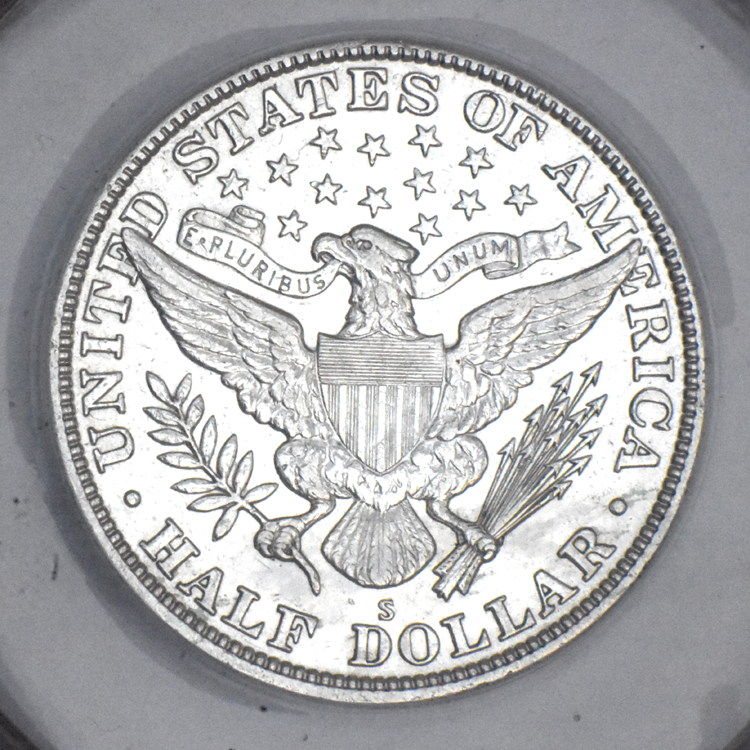 |
|
| This coin is slabbed and graded as an EF 45 and cost me $300. It does have some small scratches on the cheek but otherwise seems as good as the one above. And I can rest assured that the grade is accurate. | This is the reverse of the coin at left. 1,604,000 of these were minted. | |
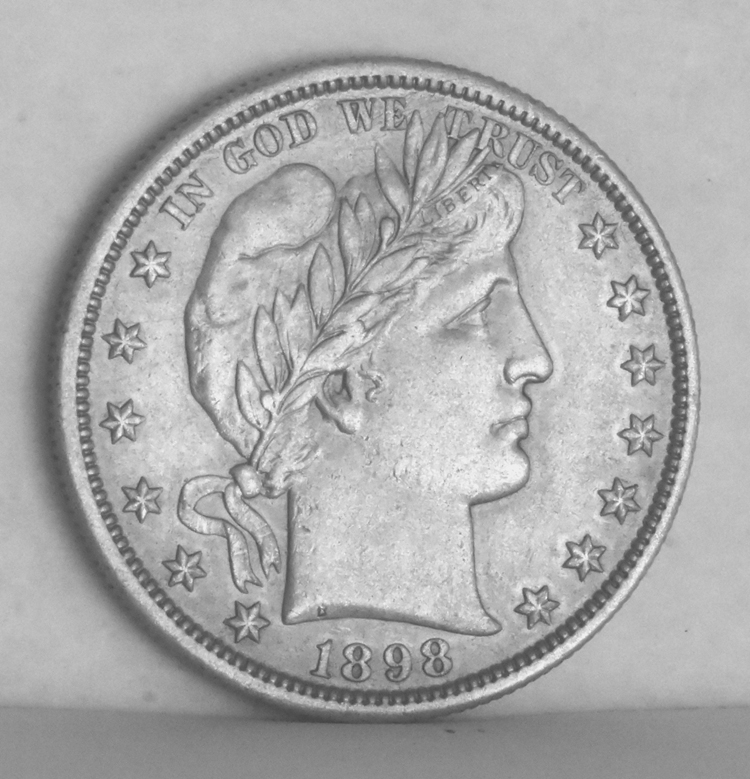 |
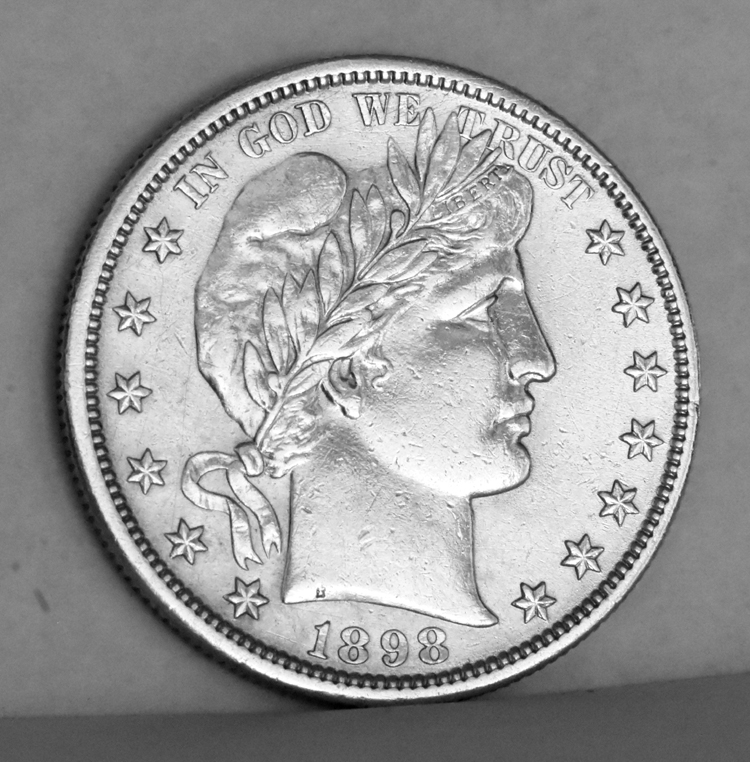 |
|
| This coin cost me $337 and I was contemplating sending it to the experts for grading because I was a trifle disappointed when it arrived; it looks darker than I anticipated and I almost yielded to an impulse to clean the coin. But I decided to send the coin to the experts for grading and was surprised to find that it actually HAD been cleaned. So I decided to clean it again, which will not seriously degrade the value further. The coin has been certified as an EF 45. It is stored in the D case. | This is the obverse of the coin after my cleaning. The reverse of the Barber half can be seen above and that reverse even has the 'S' mint mark. 2,358,550 of these were minted. |
| 1898: 15 February: USS Maine explodes and sinks in Havana harbor, Cuba, killing 266 men. Popular opinion blames Spain and helps precipitate the Spanish–American War. 28 March: After an investigation, the U.S. Navy publicly concludes that USS Maine was sunk by a mine, further pushing sentiment towards war. April 20: President William McKinley signs a Joint Resolution with Cuba and a declaration of War against Spain, beginning the Spanish–American War. The declaration is accepted five days later. April 25: Spanish–American War: The United States declares war on Spain; the U.S. Congress announces that a state of war has existed since April 21. May 1: Spanish–American War – Battle of Manila Bay: Commodore Dewey destroys the Spanish squadron. The first battle of the war, as well as the first battle in the Philippines Campaign. July 3: Spanish–American War: Battle of Santiago de Cuba – The United States Navy destroys the Spanish Navy's Caribbean Squadron. July 7: The United States annexes the Hawaiian Islands. October 3: Battle of Sugar Point: Ojibwe tribesmen defeat U.S. government troops in northern Minnesota. December 10: The Treaty of Paris is signed, ending the Spanish–American War. Exact date not known: As a result of the merger of several small oil companies, John D. Rockefeller's Standard Oil Company controls 84% of the United States's oil and most American pipelines. |
| 1908: January 3: A total solar eclipse is visible in Pacific Ocean, and is the 46th solar eclipse of Solar Saros 130. January 21: New York City passes the Sullivan Ordinance, making it illegal for women to smoke in public, only to have the measure vetoed by the mayor. January 24: Robert Baden-Powell's Scouting for Boys begins publication in London. The book eventually sold over 100 million copies, and effectively begins the worldwide Boy Scout movement. February 1: Lisbon Regicide: King Carlos I of Portugal and Prince Luis Filipe are shot dead in Lisbon. February 18: Japanese emigration to the United States is forbidden, under terms of the Gentlemen's Agreement of 1907. March 4: The Collinwood school fire near Cleveland, Ohio kills 174. March 23: American diplomat Durham Stevens, an employee of Japan's Ministry of Foreign Affairs, is assassinated in San Francisco by two Korean immigrants, unhappy with his recent support for the increasing Japanese presence in Korea. March 29: French aviator Henri Farman made the world's first flight with a passenger, Léon Delagrange. May 26: At Masjed Soleyman in southwest Persia, the first major commercial oil discovery in the Middle East is made. The rights to the resource are quickly acquired by the United Kingdom. June 30: The Tunguska event or "Russian explosion" near the Podkamennaya Tunguska River in Krasnoyarsk Krai, Siberia, Russian Empire, is believed to have been caused by the air burst of a large meteoroid or comet fragment, at an altitude of 3–6 miles above the Earth's surface. July 6: Robert Peary sets sail for the North Pole. July 27–28: The 1908 Hong Kong typhoon sinks the passenger steamer Ying King, causing 421 deaths. The Hoover Company of Canton, Ohio, acquires manufacturing rights to the upright portable vacuum cleaner just invented by James M. Spangler. September 17: At Fort Myer, Virginia, Thomas Selfridge becomes the first person to die in an airplane crash. The pilot, Orville Wright, is severely injured in the crash but recovers. October 1: Official launch of Henry Ford's Ford Model T automobile, the first having left the Ford Piquette Avenue Plant in Detroit, Michigan, on September 27. The initial price is set at US$850. November 6: Western bandits Butch Cassidy and the Sundance Kid are supposedly killed in Bolivia, after being surrounded by a large group of soldiers. There are many rumors to the contrary however, and their grave sites are unmarked. December 28: The 7.1 Mw Messina earthquake shakes Southern Italy with a maximum Mercalli intensity of XI (Extreme), killing between 75,000 and 200,000. Date unknown: According to NASA reports, 1908 was the coldest recorded year since 1880. A 40,000-year-old Neanderthal boy skeleton is found at Le Moustier in southwest France, by Otto Hauser. |
| 1915: January: While working as a cook at New York's Sloan Hospital under an assumed name, Typhoid Mary infects 25 people, and is placed in quarantine for life. January 12: The Rocky Mountain National Park is established by an act of the U.S. Congress. The United States House of Representatives rejects a proposal to give women the right to vote. March 25: The USS F-4 submarine sinks off Hawaii; 23 are killed. May 6: Babe Ruth hits his first career home run off of Jack Warhop. May 7: The RMS Lusitania is sunk on passage from New York to Britain by a German U-boat, killing 1,198. May 22: Lassen Peak, one of the Cascade Volcanoes in Northern California, erupts, sending an ash plume 30,000 feet in the air and devastating the nearby area with pyroclastic flows and lahars. It is the only volcano to erupt in the contiguous United States between 1900 and the 1980 eruption of Mount St. Helens. June 9: U.S. Secretary of State William Jennings Bryan resigns over a disagreement regarding his nation's handling of the Lusitania sinking. June 22: The Imperial Valley earthquakes shook southeastern Southern California, causing six deaths and financial losses of $900,000. Each shock in this doublet earthquake measured 5.5 Mw and had a maximum Mercalli intensity of VIII (Severe). July 24: The steamer Eastland capsizes in the Chicago River , with the loss of 844 lives. August 5–August 23: Hurricane Two of the 1915 Atlantic hurricane season over Galveston and New Orleans leaves 275 dead. October 2: The 6.8 Mw Pleasant Valley earthquake shook north-central Nevada with a maximum Mercalli intensity of X (Extreme), causing limited damage and pronounced fault scarps along the base of the Tobin Range. November 18: Release of Inspiration, the first mainstream movie in which a leading actress (Audrey Munson) appears nude. Date unknown: The first stop sign appears in Detroit, Michigan. |